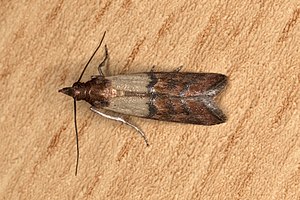Dried fruit moth
| Dried fruit moth | ||||||||||||
|---|---|---|---|---|---|---|---|---|---|---|---|---|

Dried fruit moth ( Plodia interpunctella ) |
||||||||||||
| Systematics | ||||||||||||
|
||||||||||||
| Scientific name | ||||||||||||
| Plodia interpunctella | ||||||||||||
| ( Huebner , 1813) |

The Indian meal moth ( Plodia interpunctella ) even stock Motte , grain moth or house moth called, is a butterfly from the family of the corn borer (Pyralidae). The species is now a stored product pest that is probably widespread worldwide .
features
The dried fruit moth has a wingspan of 13 to 20 millimeters and a body length of 4 to 10 millimeters. The basal part of the fore wing is colored light gray to gray-yellow, the remaining part is colored lighter or darker copper-red.
The overall development takes approx. 30 days at 30 ° C, up to approx. 74 days at 20 ° C. The adult moth lives for about 10 to 14 days and does not eat any more.
Way of life
From the up to 300 eggs (diameter <0.5 mm), caterpillars of very different colors hatch after 3–4 days, which in the course of their development molt 3 to 5 times and can reach up to 17 millimeters in length. The larvae like to sit in spine tubes and pupate after a while in hiding places outside of the food supply. The development of the moth takes 32 to 38 days under optimal conditions. The dried fruit moths are sensitive to the cold, but under good conditions they can have several generations of offspring per year. The moth lives up to two weeks. The caterpillars of the dried fruit moth eat, spin and contaminate grain products, malt, nuts , pulses , chocolate, cocoa, coffee, noodles, tea, spices, dried fruit and, in exceptional cases, fresh fruit .
Combat
Pheromone traps and parasitic wasps are used to combat them . Infested food should be disposed of, food supplies should be packed airtight, for example in glass or thick plastic containers. Noodles, chocolate, etc. originally wrapped in foil are not adequately protected, as the caterpillars may be able to penetrate certain plastic packaging (see below).
Degradation of polyethylene
In 2014, Chinese scientists reported that the dried fruit moth caterpillar could digest polyethylene . Two bacteria ( Enterobacter asburiae and an undetermined species from the genus Bacillus ) were isolated from the stomach of the caterpillar, and the bacteria left micrometer-sized pits and holes on PE film.
Web links
- Plodia interpunctella (HÜBNER, 1813) - Dried fruit moth
- Plodia interpunctella in Fauna Europaea
- Dried fruit moth
- Plodia interpunctella (Hübn.) ( Memento from June 30, 2008 in the Internet Archive )
- Ian Kimber: Guide to the moths of Great Britain and Ireland (English)
- Moths and Butterflies of Europe and North Africa (English)
- The dried fruit moth - Lower Saxony State Office for Consumer Protection and Food Safety
literature
- František Slamka: The common moth (Pyraloidea) of Central Europe: determination - distribution - flight area - way of life of the caterpillars . 2nd partially revised edition, Bratislava 1997, ISBN 80-967540-2-5
- Thomas Kaltenbach, Peter Victor Küppers: Small butterflies. Verlag J. Neudamm-Neudamm, Melsungen 1987, ISBN 3-7888-0510-2
Individual evidence
- ↑ Jun Yang, Y. u. Yang, Wei-Min Wu, Jiao Zhao, Lei Jiang: Evidence of Polyethylene Biodegradation by Bacterial Strains from the Guts of Plastic-Eating Waxworms. In: Environmental Science & Technology . 48, 2014, pp. 13776-13784, doi : 10.1021 / es504038a .

